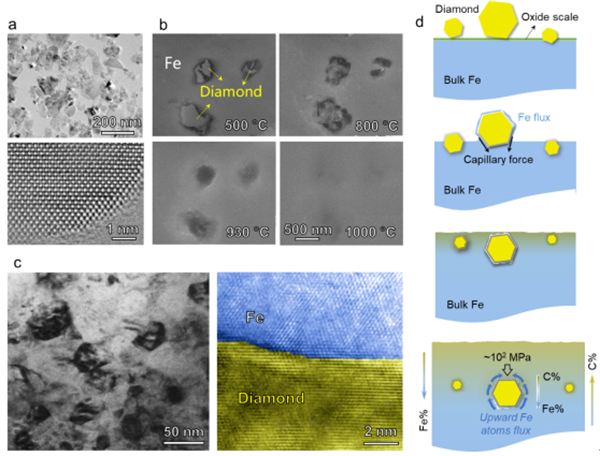XJTU's research results published in Nature Communications
A research team led by Professor Shan Zhiwei from the School of Materials Science and Engineering at Xi'an Jiaotong University (XJTU), in collaboration with a team from the Center for Alloy Innovation and Design, recently discovered that diamond particles at the scale of tens to hundreds of nanometers can autonomously move inside steel crystals and continue to "walk" inward at temperatures far below the melting point of steel. Remarkably, these particles move in their particulate form rather than as single atoms, achieving maximum travel distances of several millimeters while maintaining their diamond crystal structure.
A paper detailing this discovery and the underlying physical mechanisms, titled "Inward Motion of Diamond Nanoparticles Inside an Iron Crystal", was published in the journal Nature Communications.

Figure 1 (a) Transmission electron microscopy (TEM) characterization of the nanodiamond powder used in the study; (b) In-situ scanning observation of nanodiamond particles entering a pure iron substrate; (c) TEM characterization of nanodiamond particles inside iron; (d) Schematic illustration of the entire process and mechanism of nanodiamonds' self-driving into a steel substrate.
Due to their ultra-high strength, thermal conductivity, chemical stability, low thermal expansion coefficient, low friction coefficient, and other advantageous properties, nanodiamonds are ideal metal-strengthening particles. Based on the team's findings, infiltrating nanodiamonds into steel materials to form gradient composite materials of steel and diamond may significantly improve the surface properties of steel, such as its hardness, thermal conductivity, and wear resistance.
China is the largest producer of synthetic diamonds, accounting for over 90 percent of the world's production. With annual steel production exceeding 1 billion metric tons, which is more than half of the world's total output, China is also the largest consumer of steel, with a very high demand for applications. This research provides new insights and methods for the surface strengthening of steel materials.

